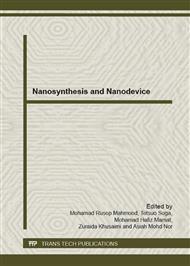[1]
S. Iijima, Helical microtubules of graphitic carbon, Nature. 354 (1991) 56-58.
DOI: 10.1038/354056a0
Google Scholar
[2]
K. An, Y. Lee, Electronic-structure engineering of carbon nanotubes, NANO: Brief Reports and Reviews. 1 (2006) 115-138.
Google Scholar
[3]
S. Prakash, M. Malhotra, W. Shao, C. Tomaro-Duchesneau, S. Abbasi, Polymeric nanohybrids and functionalized carbon nanotubes as drug delivery carriers for cancer therapy, Adv Drug Deliver Rev. (2011) 1340-1351.
DOI: 10.1016/j.addr.2011.06.013
Google Scholar
[4]
C. M. Seah, S. P. Chai, S. Ichikawa, A. R. Mohamed, Synthesis of single-walled carbon nanotubes over a spin-coated Fe catalyst in an ethanol-PEG colloidal solution, Carbon. 50 (2012) 960-967.
DOI: 10.1016/j.carbon.2011.09.059
Google Scholar
[5]
J. Shen, W. Huang, L. Wu, Y. Hu, M. Ye, Study on amino-functionalized multiwalled carbon nanotubes, Mater Sci Eng: A. 464 (2007) 151-156.
DOI: 10.1016/j.msea.2007.02.091
Google Scholar
[6]
Z. Wuxu, Z. Zhenzhong, Z. Yingge, The application of carbon nanotubes in target drug delivery systems for cancer therapies, Nanoscale Res Lett. 6 (2011) 555.
Google Scholar
[7]
F. A. Murphy, A. Schinwald, C. A. Poland, K. Donaldson, The mechanism of pleural inflammation by long carbon nanotubes: interaction of long fibres with macrophages stimulates them to amplify pro-inflammatory responses in mesothelial cells, Part Fibre Toxicol. 9 (2012).
DOI: 10.1186/1743-8977-9-8
Google Scholar
[8]
M. Kumar, Y. Ando, Chemical vapor deposition of carbon nanotubes: a review on growth mechanism and mass production, J. nanosci nanotechnol. 10 (2010) 3739-3758.
DOI: 10.1166/jnn.2010.2939
Google Scholar
[9]
F. Hennrich, R. Krupke, S. Lebedkin, K. Arnold, R. Fischer, D. E. Resasco, M. M. Kappes, Raman spectroscopy of individual single-walled carbon nanotubes from various sources, J. Phys. Chem. B. 109 (2005) 10567-10573.
DOI: 10.1021/jp0441745
Google Scholar
[10]
X. Zhao, Y. Ando, L. C. Qin, H. Kataura, Y. Maniwa, R. Saito, Radial breathing modes of multiwalled carbon nanotubes, Chem. Phys. lett. 361 (2002) 169-174.
DOI: 10.1016/s0009-2614(02)00955-7
Google Scholar
[11]
V. Raffa, G. Ciofani, S. Nitodas, T. Karachalios, D. Alessandro, M. Masini, A. Cuschieri, Can the properties of carbon nanotubes influence their internalization by living cells?, Carbon 46 (2008) 1600-1610.
DOI: 10.1016/j.carbon.2008.06.053
Google Scholar
[12]
L. Dong, C. M. Witkowski, M. M. Craig, M. M. Greenwade, K. L. Joseph, Cytotoxicity effects of different surfactant molecules conjugated to carbon nanotubes on human astrocytoma cells, Nanoscale Res Lett. 4 (2009) 1517-1523.
DOI: 10.1007/s11671-009-9429-0
Google Scholar
[13]
P. Shreekumar, Toxicity Issues Related to Biomedical Applications of Carbon Nanotubes, J. Nanomed Nanotechnol. 3 (2012) 1-15.
Google Scholar
[14]
G. Trykowski, S. Biniak, L. Stobinski, B. Lesiak, Preliminary Investigations into the Purification and Functionalization of Multiwall Carbon Nanotubes, Acta Phys Pol A. 118 (2010) 515.
DOI: 10.12693/aphyspola.118.515
Google Scholar
[15]
S. Y. Brichka, G. Prikhod'ko, Y. I. Sementsov, A. Brichka, G. Dovbeshko, O. Paschuk, Synthesis of carbon nanotubes from a chlorine-containing precursor and their properties, Carbon 42 (2004) 2581-2587.
DOI: 10.1016/j.carbon.2004.05.040
Google Scholar
[16]
Y. Chen, Z. Sun, Y. Li, B. Tay, Optimization of carbon nanotube powder growth using low pressure floating catalytic chemical vapor deposition, Mater chem. phys. 98 (2006) 256-260.
DOI: 10.1016/j.matchemphys.2005.09.017
Google Scholar


